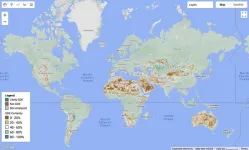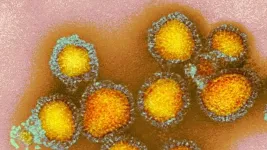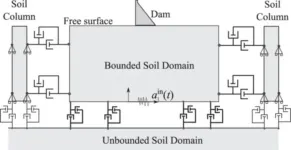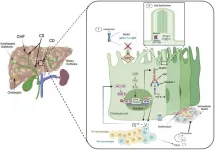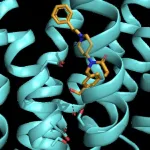(Press-News.org) (Santa Barbara, Calif.) — Where hidden water tables meet the Earth’s surface, life can thrive even in the driest locations. Offering refuge during times of drought, shallow groundwater aquifers act like water savings accounts that can support ecosystems with the moisture required to survive, even as precipitation dwindles. As climate change and human water use rapidly deplete groundwater levels around the world, scientists and policy makers need better data for where these groundwater-dependent ecosystems exist.
Now, a new study maps these ecosystems in dryland regions globally, examines their protection status and explores how they overlap with human communities.
The research, published in the journal Nature, marks the first time that groundwater-dependent ecosystems have been mapped on a global scale. The global effort brought together researchers from universities, non-profit organizations and institutions from seven countries, including UC Santa Barbara. Their results show that 53% of these ecosystems are in areas with known groundwater depletion, while only 21% exist on protected lands or regions with policies in place for their protection.
“Taken as a whole, we’ve generated many high-impact studies using new satellite approaches to map and monitor the resilience of riparian forests,” said co-author Kelly Caylor, a geography professor at UCSB. “This paper is probably the jewel in that crown, and many folks helped mine it.”
“Until now, the location of these ecosystems has been largely unknown, hindering our ability to track impacts, establish protective policies and implement conservation projects to protect them,” said Melissa Rohde, an ecohydrologist and environmental consultant who is the lead author of the study.
Ecosystems that depend on groundwater vary widely, Rohde noted, from desert springs, to mountain meadows and streams, to coastal wetlands and forests. These ecosystems are often hot spots for biological diversity worldwide and are under increasing threat from climate change and human exploitation. When Rohde’s colleagues at The Nature Conservancy offices around the world set out to conserve them, they found themselves running into a persistent lack of data, which catalyzed the mapping effort.
“These ecosystems encompass these places we really care about, but their reliance on groundwater has been unacknowledged,” she said.
Using technology to advance the science of groundwater-dependent ecosystems
Without a global dataset for the location and depths of groundwater, the research team had to get creative. They gathered six years of data from NASA’s Landsat satellite, which provides satellite imagery that can be used to estimate leaf water content, evapotranspiration, vegetation greenness, open water, and land temperatures and climate data that characterizes water availability. Then, they used more than 30,000 data points of confirmed groundwater-dependent ecosystem locations to train a computer model how to identify these areas based on the satellite data.
“This global analysis is a fascinating outcome because it builds on a legacy of work that we have been developing on riparian resilience,” Caylor said. These ideas started with work by Rhodes and UCSB scientists Dar Roberts and Michael Singer in the Santa Clara River valley, examining how riparian forests responded to the extreme drought of the mid-2010s.
The analysis takes advantage of the fact that an ecosystem supported by groundwater will remain greener, cooler and wetter than other places throughout the dry season, and this can be seen with satellite imagery. “Our approach leverages what we already know about the characteristics of these ecosystems,” Rohde said, noting that the way groundwater cools the ground surface is just one of the many ways that these ecosystems provide refuge to plants and animals.
"It continues to amaze me that we now have the data and technology to capture and analyze information for places the size of a basketball court or a swimming pool, and that we can do this across the entire globe,” said Christine Albano, an ecohydrologist at the Desert Research Institute (DRI). “Having this level of spatial detail is critical for this analysis, because it is often the groundwater-dependent springs or wetlands that are about this size, or even smaller, that are the most critical to people and wildlife.”
The result is a global map of where ecosystems dependent on groundwater existed from 2015-2020, combined with a statistical likelihood of the researchers’ confidence in each location’s groundwater dependence. “A few years ago, an analysis like this would not have been possible, but we can now leverage recent advances in machine learning and cloud computing to fill critical knowledge gaps for conservation at a global scale,” said co-author Kirk Klausmeyer, director of data science for The Nature Conservancy in California. By testing the computer model’s ability to identify known groundwater-dependent ecosystems, they estimate accuracy at around 87%.
“The intention of our map is that it be used as a starting point,” Rohde explained. “It provides essential information on where they are likely located and most at risk of groundwater depletion, so that we can advance the protection of these biologically diverse ecosystems and the societies dependent upon them.”
The map shows these ecosystems are more intact and extensive in Central Asia, the Sahel region of Africa and South America, where pastoral communities are common. This contrasts with their depletion and fragmentation in parts of the world where groundwater pumping and agricultural irrigation reign, such as North America and Australia. In the latter regions, many of these ecosystems have already been lost, as groundwater tables fall below the level where plant roots or streams can reach them.
Overcoming conservation challenges
To illustrate the role of these ecosystems in supporting rural livelihoods, the study also focused in on the Greater Sahel region of Africa, where four conflict hotspots overlap with locations containing a high number of groundwater-dependent ecosystems. Climate change is exacerbating food insecurity in these locations, resulting in crop cultivation expanding into previously pastoral lands. This demonstrates the importance of recognizing the complex interactions of climate change and land and water conservation efforts.
“These ecosystems have a direct impact on the rural livelihoods of pastoralists,” Rohde said. “While sustainable groundwater management policies may be politically tractable in some regions, humanitarian assistance that protects ecosystems for sustaining rural livelihoods or reducing conflict might be more appropriate in other regions. There need to be creative solutions to preserving these ecosystems, and that’s going to vary a lot depending on where you are in the world.”
Despite the study’s determination that 21% of groundwater-dependent ecosystems are under some level of protection, other research by the team has demonstrated that very few ecosystems are effectively protected where legislation exists. Without a better understanding of how groundwater is supporting ecosystems, even protected lands could be undermined if groundwater is lost due to unsustainable use outside protected boundaries.
“We need to acknowledge that groundwater is critical for many ecosystems,” Rohde said. “Groundwater is being pumped at rates higher than it can be replenished, but we aren’t managing or regulating it to the extent necessary to prevent further ecosystem impacts. If we want to achieve our global biodiversity goals and our climate goals, then we need to connect the dots between groundwater and ecosystems.”
END
Groundwater is key to protecting global ecosystems
New research identifies ecosystems around the world that could be threatened by declining groundwater levels
2024-07-17
ELSE PRESS RELEASES FROM THIS DATE:
A new approach to accelerate the discovery of quantum materials
2024-07-17
– By Michael Matz
Researchers at the Department of Energy’s Lawrence Berkeley National Laboratory (Berkeley Lab) and several collaborating institutions have successfully demonstrated an innovative approach to find breakthrough materials for quantum applications. The approach uses rapid computing methods to predict the properties of hundreds of materials, identifying short lists of the most promising ones. Then, precise fabrication methods are used to make the short-list materials and further ...
Influenza viruses can use two ways to infect cells
2024-07-17
Most influenza viruses enter human or animal cells through specific pathways on the cells’ surface. Researchers at the University of Zurich have now discovered that certain human flu viruses and avian flu viruses can also use a second entry pathway, a protein complex of the immune system, to infect cells. This ability helps the viruses infect different species – and potentially jump between animals and humans.
The majority of type A influenza viruses circulating in birds and pigs aren’t normally a health ...
Engineering resilience: Advanced FEM enhances earthquake impact assessment
2024-07-17
In a significant advancement for geotechnical engineering, a refined space-time finite element method (v-ST/FEM) has been introduced to tackle the complex dynamics of soil-structure interaction during seismic events. This new approach allows for more accurate simulations of the response of earth structures to earthquake vibrations, marking a crucial step in improving infrastructure resilience against natural disasters.
Designing structures like dams, tunnels, and embankments to withstand transient loads from sources such as earthquakes, high-speed trains, and explosions requires robust dynamic soil-structure interaction (SSI) analysis. Traditional methods often fall short in handling ...
The Vps21 signaling pathway regulates white-opaque switching and mating in Candida albicans
2024-07-17
This study was led by Dr. Guanghua Huang (School of Life Sciences, Fudan University). The team discovered that the conserved Vps21 signaling pathway plays critical roles in the regulation of white-opaque switching and mating in Candida albicans, a major human fungal pathogen.
Candida albicans is able to cause cutaneous diseases as well as life-threatening systemic infections in humans. It has multiple cellular morphologies and can undergo transitions among different morphologies to adapt to environmental changes. White-opaque transitions represent a typical morphological phenotypic switching system ...
Autoantibodies behind lifelong risk of viral infections
2024-07-17
A new study shows that about two percent of the population develop autoantibodies against type 1 interferons, mostly later in life. This makes individuals more susceptible to viral diseases like COVID-19. The study, conducted by UZH researchers together with a USZ team, is based on an analysis of a large collection of historical blood samples.
Virus infections trigger the cells of the immune system to release type 1 interferons. These proteins act as early messengers that warn uninfected cells and tissues that a virus is spreading. This allows ...
Heritable chronic cholestatic liver diseases
2024-07-17
Chronic cholestasis, defined as the impairment of bile acid formation and/or flow persisting for more than six months, encompasses a broad spectrum of hepatobiliary disorders, both heritable and acquired. This review focuses on heritable causes of chronic cholestasis, which, although less common, present significant clinical challenges. Heritable chronic cholestatic liver diseases are typically diagnosed in childhood, but many cases present and persist into adulthood. This review aims to highlight the genetics, clinical pathophysiology, presentation, ...
What fat cats on a diet may tell us about obesity in humans
2024-07-17
COLUMBUS, Ohio – Pet cats may be excellent animal models for the study of obesity origins and treatment in humans, a new study of feline gut microbes suggests – and both species would likely get healthier in the research process, scientists say.
Veterinary researchers analyzed fecal samples from fat cats as the animals lost and maintained weight over the course of four dietary changes, including strict calorie reduction. The team found that food-related changes to the cats’ gut microbiome – the assortment ...
Designing safer opioids
2024-07-17
Opioid medications offer people relief from debilitating pain, but these drugs come with dangers: the risk for addiction, miserable withdrawal symptoms and the potential for fatal overdose. In a study in ACS Central Science, researchers have identified a strategy to design safer opioids. They showed that an experimental opioid, which binds to an unconventional spot in the receptor, suppresses pain in animal models with fewer side effects — most notably those linked to fatal overdoses.
Opioid medications tap into the body’s natural system for mitigating pain by activating pain-suppressing ...
Completely stretchy lithium-ion battery for flexible electronics
2024-07-17
When you think of a battery, you probably don’t think stretchy. But batteries will need this shape-shifting quality to be incorporated into flexible electronics, which are gaining traction for wearable health monitors. Now, researchers in ACS Energy Letters report a lithium-ion battery with entirely stretchable components, including an electrolyte layer that can expand by 5000%, and it retains its charge storage capacity after nearly 70 charge/discharge cycles.
Electronics that bend and stretch need batteries with similar properties. Most researchers who have ...
New opportunity to improve diagnosis, care for people with cardiovascular-kidney-metabolic syndrome
2024-07-17
DALLAS, July 17, 2024 — About 1 in 3 U.S. adults have at least three risk factors for cardiovascular-kidney-metabolic (CKM) syndrome, a health disorder related to the strong connections among cardiovascular disease, kidney disease and metabolic disease (such as Type 2 diabetes and obesity).[1] Yet there is no single clinical practice guideline to treat people with CKM syndrome, and gaps exist in preventing, screening, managing and comprehensively treating these diseases.
To address this complex health threat, the American Heart Association, ...
LAST 30 PRESS RELEASES:
Antibiotic resistance is ancient, ecological, and deeply connected to human activity, new review shows
Vapes, pouches, heated tobacco, shisha, cigarettes: nicotine in all forms is toxic to the heart and blood vessels
From powder to planet: University of Modena engineers forge a low-carbon future for advanced metal manufacturing
Super strain-resistant superconductors
Pre-school health programme does not improve children’s diet or physical activity, prompting call for policy changes, study finds
Autumn clock change linked to reduction in certain health conditions
AI images of doctors can exaggerate and reinforce existing stereotypes
Where medicine meets melody – how lullabies help babies and parents in intensive care
We may never be able to tell if AI becomes conscious, argues philosopher
AI video translation shows promise but humans still hold the edge
Deep ocean earthquakes drive Southern Ocean’s massive phytoplankton blooms, study finds
Without campus leftovers to pick through, the beaks of this bird changed shape during the pandemic
High-dose antibiotic does not reduce mortality in tuberculous meningitis
How many insects fly in the sky above the USA?
Could cheese protect your brain health?
Who faces more difficulty recovering from stroke?
Colliding galaxies create the brightest, fastest growing black holes at their center
New BrainHealth research reveals tradeoffs on sleep with cannabis use for chronic pain
Aging-US now on ResearchGate, enhancing visibility for authors and readers
'Molecular glue' stabilizes protein that inhibits development of non-small cell lung cancer
Mount Sinai Health System is recognized in 2025 Chime Digital Health Most Wired survey
From prey to predator: How carnivores spread beneficial fungi
Menopause symptoms may be frequent and have negative effects, according to female endurance athletes
US Congressmembers’ responses on X to mass shooting events differ along party lines
KAIST-UEL team develops “origami” airless wheel to explore lunar caves
Individual genetic differences render some therapies ineffective
Engineering dendritic cells boosts cancer immunotherapy
Sophisticated neuroimaging reveals PTSD in WTC responders is linked to measurable physical changes in brain structure
Health policy experts identify promising strategies for providing health care to homeless people
Study explores role of neutrophils in canine atopic dermatitis
[Press-News.org] Groundwater is key to protecting global ecosystemsNew research identifies ecosystems around the world that could be threatened by declining groundwater levels
